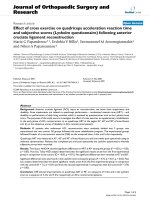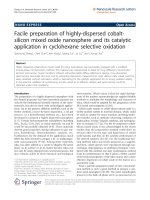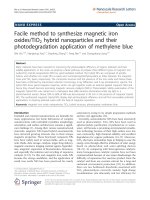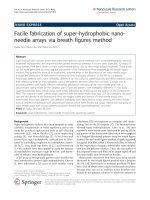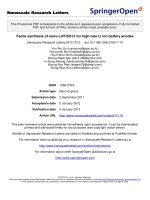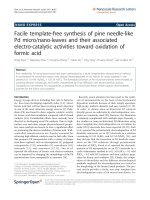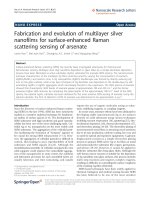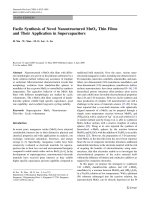Báo cáo hóa học: " Facile Hydrogen Evolution Reaction on WO3 Nanorods Janarthanan Rajeswari Æ Pilli Satyananda Kishore Æ Balasubramanian Viswanathan Æ Thirukkallam Kanthadai Varadarajan" pot
Bạn đang xem bản rút gọn của tài liệu. Xem và tải ngay bản đầy đủ của tài liệu tại đây (442.74 KB, 8 trang )
NANO EXPRESS
Facile Hydrogen Evolution Reaction on WO
3
Nanorods
Janarthanan Rajeswari Æ Pilli Satyananda Kishore Æ
Balasubramanian Viswanathan Æ Thirukkallam Kanthadai Varadarajan
Received: 13 April 2007 / Accepted: 10 August 2007 / Published online: 1 September 2007
Ó to the authors 2007
Abstract Tungsten trioxide nanorods have been gener-
ated by the thermal decomposition (450 °C) of
tetrabutylammonium decatungstate. The synthesized tung-
sten trioxide (WO
3
) nanorods have been characterized by
XRD, Raman, SEM, TEM, HRTEM and cyclic voltam-
metry. High resolution transmission electron microscopy
and X-ray diffraction analysis showed that the synthesized
WO
3
nanorods are crystalline in nature with monoclinic
structure. The electrochemical experiments showed that
they constitute a better electrocatalytic system for hydro-
gen evolution reaction in acid medium compared to their
bulk counterpart.
Keywords Tungsten trioxides Á Thermal decomposition Á
Nanorods Á Hydrogen evolution reaction Á Electrocatalyst
Introduction
One-dimensional (1D) nanostructures such as nanorods,
nanowires and nanotubes have attracted attention due to
their novel physical and chemical properties as well as their
potential use in a wide range of advanced applications in
the past decade [1, 2]. As a consequence, many synthetic
methods have been developed to prepare various 1D
nanostructures [3–6]. Of particular interest is the prepara-
tion of 1D nanostructure of tungsten trioxides (WO
3
) and
its suboxides (WO
3–x
). WO
3
is used extensively as
materials for electrochromic devices [7–10], gas sensors
[11, 12], catalysts [13, 14] and secondary batteries [15].
Several synthetic approaches including electrochemical
techniques, sonochemical approach, template mediated
synthesis, bioligation, hydrothermal, wet organic and
inorganic routes and thermal methods have been reported
to fabricate WO
3
nanorods [16–51]. A method for the
synthesis of tungsten oxide nanorods with planar defects or
textured structure has been introduced by Zhang et al. and
this method involves growth of WO
3–x
nanorods on the
tips of electrochemically etched tungsten filament [16].
However, synthesis of such structure has been possible
only in the presence of H
2
atmosphere. The nanorods of
WO
3
have also been obtained by sonochemical method
wherein Koltypin et al. have synthesized a mixture of
WO
2
–WO
3
nanorods by ultrasound irradiation of W(CO)
6
in diphenylmethane [17]. Tungsten oxide nanorods could
also be obtained from templated route by using CNTs and
colloidal gas aphrons as templates [18–20]. Therese et al.
have adopted an organic amine assisted low temperature
hydrothermal route for the synthesis of hexagonal WO
3
nanorods [23]. Inorganic compounds such as Na
2
SO
4
,
Rb
2
SO
4
and K
2
SO
4
have been demonstrated as structure
directing agents for the hydrothermal synthesis of 1-D
WO
3
nanorods by Gu et al., Lu et al. and Xiao et al. [24–
26]. Srivastava et al. have reported sol–gel followed by dip
coating to produce WO
3
nanorods [28]. By altering the
composition and concentration of solvent, it was shown
that different morphologies and phases of WO
3
nanorods
can be achieved [29]. However, all of these reported efforts
involve multistep processes and limited to the use of
directing agents such as CNTs and M
2
SO
4
(M = Na,
Rb and K). Hence, the synthesis would be tedious and
requires careful removal of the structure directing agents to
avoid contaminants. Moreover, sol–gel and hydrothermal
J. Rajeswari Á P. S. Kishore Á B. Viswanathan (&) Á
T. K. Varadarajan
Department of Chemistry, National Centre for Catalysis
Research, Indian Institute of Technology Madras,
Chennai 600 036, India
e-mail:
123
Nanoscale Res Lett (2007) 2:496–503
DOI 10.1007/s11671-007-9088-y
methods proceed with a low yield. In order to overcome the
difficulties mentioned, thermal method has been employed
widely for the large scale synthesis of tungsten oxide
nanorods/nanowires as they are simple, easy and free from
catalysts and contaminants. Heat treatment of tungsten
metal, such as, tungsten foil or tungsten filament heated at
800–1,600 °C[40–42], tungsten powder heated at 950 °C
under the Ar gas flow on ITO glass/tungsten substrate at
900–1,100 °C[44], thermal evaporation of tungsten pow-
der [45] and tungsten hexacarbonyl heated at 700 °C[39]
have yielded 1-D WO
3
nanorods. All the above thermal
methods related to 1-D tungsten oxide formation from the
gaseous phase (vapor deposition) or thermal evaporation
techniques are technically complex, require high tempera-
ture, harsh growth conditions, expensive experimental
setup and complicated control processes. Recently, the
single source molecular precursor route has opened a
useful way for the synthesis of WO
3
nanorods/nanowires
by thermal decomposition method [49–51]. It offers the
distinct advantage of simplified fabrication procedure and
equipment as compared with the thermal evaporation or
vapor deposition methods. However, multiple steps for the
synthesis of both precursor and 1-D WO
3
, longer reaction
time for precursor (6 days or 10 h) and relatively higher
pyrolysis temperature (750 °C) were required. In this
report, a facile synthesis of WO
3
nanorods based on the
thermal decomposition of tetrabutylammonium decatung-
state has been described. The method has several unique
advantages. Firstly, it has been possible to obtain high
yields of WO
3
nanorods at a relatively low temperature
(450 °C) and short reaction time as compared to previously
reported methods involving high temperature (‡700 °C).
Secondly, different morphologies of the material (nano-
sheets and nanorods) can be achieved by altering the
pyrolysis time. Moreover, the method followed for the
synthesis of precursor is a simple precipitation which does
not require any tedious experimental set up or does not
consume much time when compared to the other methods.
Finally, it is a generic method which can be applied for
synthesis of other metal oxides such as MoO
x
and V
2
O
5
by
suitably altering the metal in the precursor.
There has been a continuous interest in studying the
dimensionality-dependent properties of WO
3
and ulti-
mately to fabricate nanodevices. Wang et al. have shown
high Li intercalation capacity (1.12 Li per formula unit) for
WO
3
nanorods than its bulk counterpart (0.78 Li per for-
mula unit) [31]. The enhanced electrochemical
performance has been attributed to the unique rod-like
structure combined with increased edge and corner effects.
Non stoichiometric WO
2.72
nanorods are found to function
as sensors with extraordinary sensing ability and the
activity has been attributed to the very small grain size and
high surface to volume ratios associated with the nanorods
[43]. Liu et al. have exhibited low turn on field for elec-
tronic emission by WO
2.9
nanorods [46]. Photoluminescent
emission spectrum of tungsten oxide nanorods was found
to show an additional blue emission peak at 437 nm than
its bulk system [30]. All these results show the unique
properties of WO
3
nanorods in comparison to their bulk
counterpart. Similar enhanced activity can be expected for
WO
3
nanorods in hydrogen evolution reaction. The aim of
the current study is to verify such a supposition experi-
mentally which is significant in the development of
electrodes for electrochemical hydrogen production.
In recent years, hydrogen, in combination with fuel
cells, has been proposed as a major alternative energy
source. It provides energy at less environmental damage,
with greater efficiency and acceptable cost compared to the
conventional fossil fuels. Electrochemical production is
one of the possible methods for hydrogen production.
Materials such as Raney Ni, Ni–Mo and noble metals such
as Pt, Pd and Ru have been employed for this purpose [52–
55]. Inspite of their high catalytic activity for hydrogen
evolution reaction, the process involving Pt and Pd are not
commercialized due to their high cost and low abundance.
This has lead to the investigation of newer materials or
reduction of the loading of noble metals. Savadogo et al.
have shown the HER using nickel electrodes with phos-
photungstic acid. It has been demonstrated that the
presence of W in the form of WO
3
in the polyoxometalates
enhanced the electrocatalytic activity for hydrogen evolu-
tion [56, 57]. Baruffladi et al. have shown electrodeposited
composites of non-stoichiometric tungsten oxides and
either RuO
2
or IrO
2
to catalyze the hydrogen evolution in
acid medium [58]. Platinum when supported on tungsten
trioxide showed electrocatalytic activity for HER due to the
synergism towards reactions in acid involving hydrogen
atoms [59]. All these results show the significance of WO
3
in hydrogen evolution reaction.
In this article, we report a surfactant directed large scale
synthesis of monoclinic WO
3
nanorods. This has been
achieved by a simple pyrolysis of a single source precursor
which consists of surfactant encapsulated tungsten oxide
clusters. The employed route is template free, contaminant
free, easy, economical and requires a low temperature for
the fabrication of WO
3
nanorods. The morphology,
chemical composition and structure were characterized by
Scanning Electron Microscopy (SEM), Transmission
Electron Microscopy (TEM), High resolution transmission
electron microscopy (HRTEM) and X-ray diffraction
(XRD). The as-synthesized tungsten trioxide nanorods
have been employed as an electrocatalyst for hydrogen
evolution reaction (HER). The electrocatalytic activity of
the material for HER was investigated by cyclic voltam-
metry, linear sweep voltammetry and Tafel plots. The
activity was compared with that of commercially obtained
Nanoscale Res Lett (2007) 2:496–503 497
123
bulk tungsten trioxide. Enhanced catalytic activity has been
observed for WO
3
nanorods compared to bulk WO
3
as an
electrocatalyst for HER.
Experimental
Materials
The commercial tungsten trioxide was purchased from Alfa
Aesar. All other chemicals were purchased from Sisco
Research Laboratories Pvt. Ltd and used as received.
Preparation of Tungsten Trioxide Nanorods
Tungsten trioxide nanorods have been synthesized by using
tetrabutylammonium decatungstate as the precursor mate-
rial. The starting material was prepared according to the
work described elsewhere [60]. The typical procedure
involved the precipitation of tetrabutylammonium deca-
tungstate by adding an aqueous tetrabutyl ammonium
bromide solution to a clear yellow solution of tungstic acid
preformed using sodium tungstate and concentrated
hydrochloric acid. The white precipitate was washed with
boiling water and ethanol, filtered, dried and then recrys-
tallized in hot dimethyl formamide to give yellow crystals.
The thermogravimetric analysis revealed that the tetrabu-
tylammonium cation content in the compound is 29.0%
(theoretical value: 29.2%) and the decomposition temper-
ature is around 450 °C as reported [60]. The synthesis of
tungsten trioxide (WO
3
) nanorods from tetrabutylammo-
nium decatungstate ((C
4
H
9
)
4
N)
4
W
10
O
32
) is carried out as
follows: The precursor compound (1 g) was taken in an
alumina or quartz boat and loaded inside a tubular furnace
and heated at 450 °C at a heating rate of 25 °C per min
under Ar atmosphere for 3 h. This was followed by gradual
cooling to room temperature to obtain a blue powder of
WO
3
nanorods. The total yield of the obtained material was
71% by weight (relative to the starting material). To further
investigate the role of tetrabutylammonium (TBA) group
on the morphology of WO
3
, an experiment has been carried
out in the absence of tetrabutylammonium ion. To achieve
this, (NH
4
)
10
H
2
W
12
O
42
Á XH
2
O has been taken as the
precursor and pyrolysed under similar experimental
conditions that were employed for the formation of WO
3
nanorods.
Structural Characterization
X-Ray Diffraction (XRD) patterns were obtained by a
powder diffractometer (XRD - SHIMADZU XD-D1) using
a Ni-filtered CuKa X-ray radiation source. CRM 200
Raman spectrometer was employed, using the 514.5 nm
line of an Ar ion laser as the excitation source. The mor-
phology of the WO
3
nanorods was investigated by a
scanning electron microscopy (SEM) (FEI, Model: Quanta
200). Transmission electron microscopy (TEM), Electron
diffraction and Energy Dispersive X-ray Analysis (EDAX)
were performed on a Philips CM12/STEM instrument.
High-resolution Transmission Electron Microscopy
(HRTEM) was carried out on a JEOL 3010.
Electrochemical Characterization
A three electrode cell consisting of the glassy carbon as
working electrode (0.07 cm
2
), Pt wire and Ag/AgCl (satd.
KCl) electrodes as counter and reference electrodes
respectively were used. All electrochemical measurements
were performed using a CHI660A potentiostat/galvanostat.
The working electrodes for electrochemical measurements
were fabricated by dispersing 5 mg of the catalyst in
100 lL of deionized water by ultrasonication for 20 min.
From this dispersion 10 lL has been taken and placed on a
glassy carbon electrode. The solvent was slowly evapo-
rated by placing the electrode in an oven at 70 °C. Five
microliter of nafion solution has been coated on the elec-
trode as a binder and dried at room temperature. One molar
H
2
SO
4
was used as the electrolyte. The electrolyte solution
was deaerated with high purity N
2
(99.99%) for 30 min
before the electrochemical measurements.
Results and Discussion
A schematic representation of the formation of WO
3
nanorods is shown in Fig. 1. It shows the possible mech-
anism of tungsten trioxide nanorods formation. The
Fig. 1 Scheme for the
formation of WO
3
nanorods
498 Nanoscale Res Lett (2007) 2:496–503
123
precursor material is composed of the cationic surfactant
group (tetrabutyl ammonium ion) and the anionic deca-
tungstate ion, represented as octahedral units [60].
Formation of the precursor can be understood as follows:
The TBA
+
cations react with the tungsten oxide octahedra
(Fig 1a) and forms lamellar aggregates (also supported
from the SEM image Fig 3a) of the ((C
4
H
9
)
4
N)
4
W
10
O
32
in
which the tungstate anions are encapsulated in the array of
TBA groups. The TBA groups are suggested to behave as
glue that holds the WO
6
octahedra together with spacing
between different lamellar layers (Fig 1b). In the crystal-
lization process, surfactant molecules may serve as a
growth controller, as well as an agglomeration inhibitor, by
forming an encapsulated layer. When heated at 450 °C for
2 h, the structure directing, tetrabutylammonium group
decomposes resulting in the formation of lamellar sheets of
WO
3
(Fig 1c). On gradual increase of the pyrolysis dura-
tion to 3 h these lamellar sheets were rolled onto
themselves to form WO
3
nanorods (Fig. 1d). The presence
of tetrabutylammonium group in the precursor plays a vital
role in the formation of nanorods. The hydrophilic head
group of the surfactant binds to the W
10
O
32
4–
anions. During
this process the hydrophobic tail groups form a shield
outside the anionic octahedra which prevents their
agglomeration. The presence of the surfactant coating is of
key importance not only for hydrophilic stabilization of the
octahedra, but also for controlling long range self-assembly
in concentrated dispersions.
Figure 2a shows the XRD recorded for WO
3
nanorods
synthesized by a single step pyrolysis of tetrabutylammo-
nium decatungstate. All the peaks can be undisputedly
indexed to monoclinic WO
3
(JCPDS: 75–2072). There are
no peaks detected for other phases, indicating that single
phase of WO
3
with high purity has been prepared. No
peaks of impurities were detected from this pattern. The
average crystallite sizes of the nanorods was calculated by
using Scherrer’s formula
L ¼ 0:89 k=b cos h;
where, L is the average crystallite size, k = 0.15418 nm
for CuKa, b is the half maximum peak width and h is the
diffraction angle in degrees. The average crystallite sizes
calculated by the Scherrer’s formula along the (001),
(020), (200), (021) and (220) have values of about 36, 27,
34, 39 and 33 nm, respectively. The Raman spectrum
(Fig. 2b) for the material shows characteristic O–W–O
bending (260 and 334 cm
–1
) and stretching modes (703
and 813 cm
–1
)ofWO
3
. The typical morphology of the
precursor compound, tetrabutylammonium decatungstate,
((C
4
H
9
)
4
)N)
4
W
10
O
32
and the as synthesized WO
3
are
presented in the SEM images (Fig. 3a, b, respectively).
Figure 3a displays the side view of the precursor
compound revealing a lamellar aggregations. Figure 3b
presents the image of the as synthesized WO
3
showing
the formation of nanorods. The rods are polydispersed
with few hundred nanometers (100–500 nm) of length
and 20–60 nm of width. Thus the findings indicate that
the pyrolysis products are obtained from the
((C
4
H
9
)
4
)N)
4
W
10
O
32
microsheets and the synthesized
material constitutes nanosized one dimensional tungsten
oxide materials. Figure 3c displays the SEM image of the
WO
3
obtained from the pyrolysis of ammonium para-
tungstate, (NH
4
)
10
H
2
W
12
O
42
Á XH
2
O. It can be seen that
the material is composed of irregular particles of varying
size with plate like morphology. From the SEM analysis,
it is revealed that rod like morphology can be obtained
only when tetrabutylammonium group is present in the
precursor compound. SEM has also been employed to
observe the morphology of the commercially obtained
WO
3
(Fig 3d). It shows agglomerated microparticles with
Fig. 2 (a) Powder X-ray diffraction pattern and (b) Raman spectrum
of WO
3
nanorods
Nanoscale Res Lett (2007) 2:496–503 499
123
no specific morphology. TEM was also employed to
provide further insight into structure and morphology of
the as synthesized material. The morphologies of the
products obtained after 2 h and 3 h were confirmed by the
TEM images to be nanosheet (Fig. 4a) and nanorod
(Fig. 4b, c), respectively. The sheet has a dimension of
about 350 nm and 190 nm lateral size and thickness,
respectively. The dimensions of the nanorods vary in
ranges 130–480 nm and 18–56 nm of length and width,
respectively. The high resolution TEM image of a nano-
rod is illustrated in Fig. 4d. The lattice fringes are
explicitly clear with d spacing of 0.375 nm for the (020)
plane. There has been a strong correlation on the d value
obtained from the HRTEM and XRD. The electron dif-
fraction shown in the inset of Fig. 4c indicates the
crystallinity of the material. The EDAX (Fig. 5) results
Fig. 3 (a) SEM images of
tetrabutylammonium
decatungstate, (b)WO
3
nanorods obtained from the
pyrolysis of
tetrabutylammonium
decatungstate, (c)WO
3
obtained
from the pyrolysis of
ammonium paratungstate and
(d) commercially obtained WO
3
Fig. 4 TEM images of WO
3
obtained from
tetrabutylammonium
decatungstate at various
pyrolysis time. (a) 2 h and (b, c)
3h,(d) HRTEM image of a
WO
3
nanorods. Inset of Fig.4c
Electron diffraction pattern of
WO
3
nanorods
500 Nanoscale Res Lett (2007) 2:496–503
123
confirmed the presence of respective constituent elements
in WO
3
nanorods. The copper signals originate from a
copper supporting microgrid.
Tungsten trioxides in sulfuric acid medium form tung-
sten bronzes which are highly electron and proton
conducting [61–63]. The redox processes involved in acid
medium can be represented as follows: During the forward
process represented in Eq. 1, H
x
WO
3
(tungsten bronze) is
formed and in the reverse process (Eq. 2), hydrogen is
evolved.
xH
þ
þ xe
À
þ WO
3
! H
x
WO
3
ð1Þ
H
x
WO
3
! x=2H
2
þ WO
3
ð2Þ
Figure 6a and b shows the cyclic voltammograms of WO
3
nanorods (as synthesized) and bulk WO
3
(commercial)
respectively on glassy carbon electrode in 1 M H
2
SO
4
at a
scan rate of 25 mV s
–1
. The bare glassy carbon electrode
(GCE) shows no activity towards hydrogen evolution
(Fig. 6c). WO
3
nanorods show a broad anodic peak at
potential 0.1 V whereas the peak has shifted towards
positive potential (0.2 V) for bulk WO
3
. The anodic peak
current density of WO
3
nanorods and bulk WO
3
are 14 mA
cm
–2
and 5 mA cm
–2
, respectively, at a scan rate of 25 mV
s
–1
. The current density for WO
3
nanorods is enhanced by
2.8 times to that of the bulk WO
3
. The lower anodic peak
potential and higher current density for WO
3
nanorods
reveal the facile formation of tungsten bronzes in nanorods
compared to the bulk material.
The stability of electrode in working electrolyte is one
of the important properties when it is applied in industrial
production [64]. CV is employed to investigate the stability
of the electrode. Figure 7a and b shows the cyclic vol-
tammograms of WO
3
nanorods and bulk WO
3
respectively
in 1 M H
2
SO
4
at a scan rate of 25 mV s
–1
for 50 consec-
utive cycles. For the WO
3
nanorods almost no activity
variation was observed even after several cycles indicating
its stability in sulfuric acid medium. Where as for the bulk
WO
3
, the peak current was observed to decrease as the
cycle number increases. This shows the poor stability of
bulk WO
3
in acid medium. This result is in agreement with
Fig. 5 EDX spectrum of WO
3
nanorods
Fig. 6 Cyclic voltammograms of (a)WO
3
nanorods, (b) bulk WO
3
and (c) bare glassy carbon electrode in 1 M H
2
SO
4
at a scan rate of
25 mV s
–1
Fig. 7 Cyclic voltammograms
of (a)WO
3
nanorods and (b)
bulk WO
3
for 50 cycles in 1 M
H
2
SO
4
at a scan rate of 25 mV
s
–1
Nanoscale Res Lett (2007) 2:496–503 501
123
the stability of the nanostructures of WO
3
described by Lee
et al. [65] and Ganesan et al. [66]. It has been demonstrated
that the nanoparticles of WO
3
and WO
3
microspheres
exhibit excellent cycling stability in 1 M H
2
SO
4
compared
to the amorphous WO
3
films. The linear sweep voltam-
mograms of WO
3
nanorods and bulk WO
3
carried out in
1MH
2
SO
4
at a scan rate of 5 mV s
–1
in the potential range
–0.2 to –0.8 V are shown in Fig. 8a and b, respectively.
The bare glassy carbon electrode showed no activity
towards hydrogen evolution as evident from the Fig. 8c. At
–0.8 V, the current densities of HER on WO
3
nanorods
(23 mA cm
–2
) is higher than that of bulk WO
3
(15 mA cm
–2
)
indicating the enhanced electrocatalytic activity of WO
3
nanorods. The kinetic parameters of the electrodes were
determined from the Tafel plot as shown in Fig. 9 and the
data are summarized in Table 1. The Tafel plots show two
well-defined linear regions for both bulk WO
3
as well as
WO
3
nanorods. The slopes in the low current density
region (region 1) for bulk WO
3
and WO
3
nanorods are –
213 and –188 mV A
–1
cm
2
, respectively. The slopes are –
30 and –25 mV A
–1
cm
2
in the high current density region
for bulk WO
3
and WO
3
nanorods respectively (region 2).
The lower Tafel slope obtained for WO
3
nanorods in
comparison to bulk WO
3
indicates the facile HER on WO
3
nanorods as the electrode. The exchange current densities
calculated at –0.199 V (Ag/AgCl (Satd KCl)) for 1 M
H
2
SO
4
solution provides information on the catalytic
activity of the electrode for HER. The higher exchange
current density value of WO
3
nanorods (2.75 · 10
–6
Acm
–2
)
when compared to bulk WO
3
(8.57 · 10
–7
Acm
–2
) shows
the better catalytic performance of WO
3
nanorods
towards HER. The results can be attributed to the unique
electrochemical behavior of 1-D nanostructures. 1-D
nanostructures provide large electrode-electrolyte interface
for the reaction to take place in a facile manner. Moreover,
it has also been reported that the nanorod and nanowire
form of the material is considered to influence its physical
properties, which depart from the properties of their bulk
phases due to the quantum effects related to the shape and
size [67]. Thus it is demonstrated that improved HER
activity can be achieved by using WO
3
nanorods as an
electrocatalyst.
Conclusions
In summary, we demonstrate a thermal decomposition
method for the synthesis of 1-D WO
3
nanorods in high
yield using a single source precursor. One of the important
aspects of this method is the in situ formation of nano-
structures due to the surfactant encapsulated metal oxide
clusters. The advantage of this method is the tunability of
the metal precursor and the surfactant group. This aspect of
the method can be exploited for the synthesis of several
other transition metal oxide nanorods. We have also syn-
thesized nanorods of molybdenum oxide and mixed oxides
of molybdenum and vanadium using similar strategy. The
Fig. 8 Linear sweep voltammograms of (a)WO
3
nanorods and (b)
bulk WO
3
and (c) bare glassy carbon electrode in 1 M H
2
SO
4
at a
scan rate of 5 mV s
–1
Fig. 9 Tafel plots for HER on WO
3
nanorods and bulk WO
3
in 1 M
H
2
SO
4
at a scan rate of 2 mV s
–1
Table 1 Electrochemical parameters of the HER obtained from the
Tafel plots for different electrode materials
Electrode Slope, b (V A
–1
cm
2
) i
o
(A cm
–2
)
Region 1 Region 2
Bulk WO
3
–213 –30 8.57 · 10
–7
WO
3
nanorods –188 –25 2.75 · 10
–6
502 Nanoscale Res Lett (2007) 2:496–503
123
as synthesized WO
3
nanorods perform well as an electro-
catalyst with enhanced electrocatalytic activity for HER
when compared to its bulk counterpart. The results show
the possibility of minimizing the loading of noble metal
electrocatalyst for HER by using WO
3
nanorods as catalyst
support.
References
1. S. Iijima, Nature 354, 56 (1991)
2. M.H. Huang, S. Mao, H. Feick, H. Yan, Y. Wu, H. Kind,
E. Weber, R. Russo, P. Yang, Science 292, 1897 (2001)
3. Z. Kang, E. Wang, M. Jiang, S. Lian, Y. Li, C. Hu, Eur. J. Inorg.
Chem. 2, 370 (2003)
4. Y.N. Xia, J.A. Rogers, K.E. Paul, G.M. Whitesides, Chem. Rev.
99, 1823 (1999)
5. X. Wang, J. Zhuang, Q. Peng, Y. Li, Nature 437, 121 (2005)
6. V.F. Puntes, K.M. Krishnan, A.P. Alivisatos, Science 291, 2115
(2001)
7. M. Andrei, A. Roggero, L.M.S. Passerini, Polymer 35, 3592
(1994)
8. J.G. Zhang, D.K. Benson, C.E. Tracy, S.K. Deb, A.W. Czand-
erna, R.S. Crandall, J. Electrochem. Soc. 141, 2795 (1994)
9. Y. Li, Y. Aikawa, A. Kishimoto, T. Kudo, Electrochim. Acta. 39,
807 (1994)
10. W. Cheng, E. Baudrin, B. Dunn, J.I. Zink, J. Mater. Chem. 11,92
(2001)
11. H.M. Lin, C.M. Hsu, H.Y. Yang, P.Y. Lee, C.C. Yang, Sens.
Actuators, B Chem. 22, 63 (1994)
12. A.A. Tomchenko, I.L. Emelianov, V.V. Khatko, Sens. Actuators
B Chem. 57, 166 (1999)
13. W. Sun, L. Xu, Y. Chu, W. Shi, J. Colloid Interface Sci. 266,99
(2003)
14. J.H. Pan, W.I. Lee, Chem. Mater. 18, 847 (2006)
15. B. Goldner, F.O. Arntz, T.E. Haas, Solar Energy Mater. Solar
Cells 32, 421 (1994)
16. H. Zhang, M. Feng, F. Liu, L. Liu, H. Chen, H. Gao, J. Li, Chem.
Phys. Lett. 389, 337 (2004)
17. Y. Koltypin, S.I. Nikitenko, A. Gedanken, J. Mater. Chem. 12,
1107 (2002)
18. B.C. Satishkumar, A. Govindaraj, M. Nath, C.N.R. Rao, J. Mater.
Chem. 10, 2115 (2000)
19. N. Shankar, M.F. Yu, S.P. Vanka, N.G. Glumac, Mater. Lett. 60,
771 (2006)
20. S.F. Abdullah, S. Radiman, M.A.Abd. Hamid, N.B. Ibrahim,
Coll. Surf. A. 280, 88 (2006)
21. J. Polleux, N. Pinna, M. Antonietti, M. Niederberger, J. Am.
Chem. Soc. 127, 15595 (2005)
22. J. Polleux, A. Gurlo, N. Barsan, U. Weimar, M. Antonietti,
M. Niederberger, Angew. Chem. Int. Ed. 45, 261 (2006)
23. H.A. Therese, J. Li, U. Kolb, W. Tremel, Solid State Sci. 7,67
(2005)
24. X.W. Lou, H.C. Zeng, Inorg. Chem. 42, 6169 (2003)
25. Z. Gu, T. Zhai, B. Gao, X. Sheng, Y. Wang, H. Fu, Y. Ma, J. Yao,
J. Phys. Chem. B. 110, 23829 (2006)
26. Z. Xiao, L. Zhang, Z. Wang, Q. Lu, X. Tian, H. Zeng, Mater.
Lett. 61, 1718 (2007)
27. B.B. Lakshmi, P.K. Dorhout, C.R. Martin, Chem. Mater. 9
, 857
(1997)
28. A.K. Srivastava, S.A. Agnihotry, M. Deepa, Thin Solid Films
515, 1419 (2006)
29. H.G. Choi, Y.H. Jung, D.K. Kim, J. Am. Ceram. Soc. 88, 1684
(2005)
30. K. Lee, W.S. Seo, J.T. Park, J. Am. Chem. Soc. 125, 3408 (2003)
31. Q. Wang, Z. Wen, Y. Jeong, J. Choi, K. Lee, J. Li, Nanotech-
nology 17, 3116 (2006)
32. G. Gu, B. Zheng, W.Q. Han, S. Roth, J. Liu, Nano Lett. 2, 849
(2002)
33. M. Gillet, R. Delamare, E. Gillet, J. Crystal Growth 279,93
(2005)
34. Z.W. Liu, Y. Bando, C.C. Tang, Chem. Phys. Lett. 372, 179
(2003)
35. C. Klinke, J.B. Hannon, L. Gignac, K. Reuter, P. Avouris,
J. Phys. Chem. B. 109, 17787 (2005)
36. Y. Li, Y. Bando, D. Golberg, K. Kurashima, Chem. Phys. Lett.
367, 214 (2003)
37. Y. Li, Y. Bando, D. Golberg, Adv. Mater. 15, 1294 (2003)
38. M. Gillet, R. Delamare, E. Gillet, Eur. Phys. J. D 34, 291 (2005)
39. B. Park, K. Yong, Surf. Rev. Lett. 12, 745 (2005)
40. D.Z. Guo, K.Y. Zhang, A. Gloter, G.M. Zhang, Z.Q. Xue,
J. Mater. Res. 19, 3665 (2004)
41. Y. Shingaya, T. Nakayama, M. Aono, Sci. Tech. Adv. Mater. 5,
647 (2004)
42. A. Rothschild, J. Sloan, R. Tenne, J. Amer. Chem. Soc. 122, 5169
(2000)
43. Y.S. Kim, S.C. Ha, K. Kim, H. Yang, S.Y. Choi, Y.T. Kim, Appl.
Phys. Lett. 86, 213105 (2005)
44. C.C. Liao, F.R. Chen, J.J. Kai, Sol. Energy Mater. Solar Cells 90,
1147 (2006)
45. Y. Baek, K. Yong, J. Phys. Chem. C 111, 1213 (2007)
46. J. Liu, Z. Zhang, Y. Zhao, X. Su, S. Liu, E. Wang, Small 1, 310
(2005)
47. Y. Baek, Y. Song, K. Yong, Adv. Mater. 18, 3105 (2006)
48. W.B. Hu, Y.Q. Zhu, W.K. Hsu, B.H. Chang, M. Terrones,
N. Grobert, H. Terrones, J.P. Hare, H.W. Kroto, D.R.M. Walton,
Appl. Phys. A. 70, 231 (2000)
49. S.V. Pol, V.G. Pol, G.A. Seisenbaeva, L.A. Solovyov, A. Ge-
danken, Inorg. Chem. 44, 9938 (2005)
50. Y. Li, X. Li, Z.X. Deng, B. Zhou, S. Fan, J. Wang, X. Sun,
Angew. Chem. Int. Ed. 41, 333 (2002)
51. X.L. Li, J.F. Liu, Y.D. Li, Inorg. Chem. 42, 921 (2003)
52. I. Paseka, Electrochim. Acta 47, 921 (2001)
53. M.D. Curtis, M.D. McClain, Chem. Mater. 8, 936 (1996)
54. M. Wu, P.K. Shen, Z. Wei, S. Song, M. Nie, J. Power Sources
166, 310 (2007)
55. E. Fachinotti, E. Guerrini, A.C. Tavares, S. Trasatti, J. Electro-
anal. Chem.
600, 103 (2007)
56. O. Savadogo, E. Ndzebet, J. Appl. Electrochem. 23, 915 (1993)
57. O. Savadogo, Mater. Chem. Phys. 35, 145 (1993)
58. C. Baruffaldi, S. Cattarin, M. Musiani, Electrochim. Acta 48,
3921 (2003)
59. S.A. Abbaro, A.C.C. Tseung, D.B. Hibbert, J. Electrochem. Soc.
127, 1106 (1980)
60. A. Chemseddine, C. Sanchez, J. Livage, J.P. Launay, M. Four-
nier, Inorg. Chem. 23, 2609 (1984)
61. P.J. Kulesza, L.R. Faulkner, Colloid Surface 41, 123 (1989)
62. B. Reichman, A.J. Bard, J. Electrochem. Soc. 126, 2133 (1979)
63. B. Reichman, A.J. Bard, J. Electrochem. Soc. 127, 647 (1980)
64. H. Zheng, J. Huang, W. Wang, C. Ma, Electrochem. Commun. 7,
1045 (2005)
65. S.H. Lee, R. Deshpande, P.A. Parilla, K.M. Jones, B. To, A.H.
Mahan, A.C. Dillon, Adv. Mater. 18, 763 (2006)
66. R. Ganesan, J.S. Lee, J. Power Sources 157, 217 (2006)
67. C.N.R. Rao, F.L. Deepak, G. Gundaih, A. Govindaraj, Prog.
Solid. Chem. 31, 5 (2003)
Nanoscale Res Lett (2007) 2:496–503 503
123
